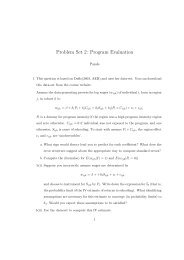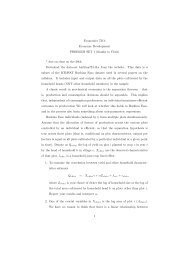The Expected Utility Model: Its Variants, Purposes, Evidence and ...
The Expected Utility Model: Its Variants, Purposes, Evidence and ...
The Expected Utility Model: Its Variants, Purposes, Evidence and ...
Create successful ePaper yourself
Turn your PDF publications into a flip-book with our unique Google optimized e-Paper software.
Schoemaker: <strong>The</strong> <strong>Expected</strong> <strong>Utility</strong> <strong>Model</strong><br />
549<br />
alternatives, another aspect-say a price<br />
level-is selected, <strong>and</strong> all restaurants that exceed<br />
the selected price level are eliminated.<br />
<strong>The</strong> process continues until only one restaurant<br />
that includes all the selected aspects remains<br />
[Tversky, 1972, p. 3491.<br />
Another lexicographic model was proposed<br />
by Payne <strong>and</strong> Braunstein (1971) in<br />
their study of pairs of duplex gambles.<br />
Subjects first compared probabilities. If<br />
the difference was sufficiently large a<br />
choice would be made on this basis alone.<br />
If not, dollar dimensions would be considered.<br />
A detailed review of lexicographic<br />
models can be found in Fishburn (1974).<br />
An alternative approach is Tversky's<br />
(1969) additive difference model mentioned<br />
earlier (p. 542). Empirical evidence<br />
for this compensatory model comes from<br />
several marketing studies involving binary<br />
product choices. J. Edward Russo <strong>and</strong><br />
Barbara Dosher (1981) used eye-fixation<br />
sequences (i.e., whether subjects examined<br />
information across rows or columns)<br />
as well as verbal protocols to demonstrate<br />
that subjects first estimate utility differences<br />
within dimensions <strong>and</strong> then combine<br />
these estimates across dimensions.<br />
Small differences are often ignored. Similar<br />
results were reported by Willem Van<br />
Raaij (1977), who examined consumer information-processing<br />
strategies under<br />
various task structures. <strong>The</strong> prevalence of<br />
such decomposed evaluation strategies<br />
raises serious doubts about EU theory's<br />
holistic approach.<br />
A second important principle of choice<br />
is that decision strategies vary with task<br />
complexity. As Payne (1976) showed,<br />
when alternatives <strong>and</strong> dimensions are numerous,<br />
subjects tend to use conjunctive<br />
<strong>and</strong> lexicographic models as initial screening<br />
rules. -with fewer attributes, holistic<br />
are probable.<br />
with just two alternatives <strong>and</strong> many different<br />
attributes the additive difference<br />
model is predominant. <strong>The</strong> idea of variable<br />
strategies <strong>and</strong> mixed scanning was also<br />
proposed by Amitai Etzioni (1967), <strong>and</strong><br />
Irving Janis <strong>and</strong> Leon Mann (1977). Interesting<br />
evidence comes from studies on decision<br />
time <strong>and</strong> task complexity by Charles<br />
Kiesler (1966), who examined how much<br />
time children took in choosing one piece<br />
of c<strong>and</strong>y from four alternatives. Surprisingly,<br />
the decision times were shorter<br />
when all four pieces were about equally<br />
attractive than when two were attractive<br />
<strong>and</strong> two unattractive! This finding suggests<br />
a greater motivation to be optimal<br />
with simple than with complex choices.<br />
Such aspiration shifts are likely to affect<br />
decision strategies markedly (Hogarth,<br />
1975b) in ways counter to EU theory.<br />
A third important principle of choice<br />
is that of isolation. According to EU theory,<br />
decision making requires a portfolio<br />
perspective (Markowitz, 1952). For instance,<br />
a decision concerning a particular<br />
insurance policy would, in theory, depend<br />
on all other risks one faces. However, people<br />
may not approach decisions in this<br />
comprehensive way, <strong>and</strong> simply treat<br />
problems in isolation. Tversky <strong>and</strong> Kahneman<br />
(1981) demonstrated that violations<br />
of first-order stochastic dominance can be<br />
induced easily because of isolation.15 Another<br />
example they discuss concerns the<br />
treatment of a $20 loss. Say that in one<br />
scenario you purchase a $20 theater<br />
ticket, which you then lose while waiting<br />
in the lobby. Would you buy a new ticket<br />
In the other scenario you are about to purchase<br />
this same theater ticket, but upon<br />
opening your wallet you discover that $20<br />
is missing. Would you still buy the ticket<br />
Because of the way people partition decision<br />
contexts, the $20 loss seems less relevant<br />
to the second than to the first choice.<br />
l6 A r<strong>and</strong>om variable is said to stochastically dominate<br />
another different r<strong>and</strong>om variable 0 to the first<br />
degree (or order) if the cumulative probability function<br />
of nowhere exceeds that of 0. If so, the expected<br />
utility of will be higher than that of 0 for<br />
my monotonic utilityfunction (joseph Hadar<br />
William Russell, 1969).




